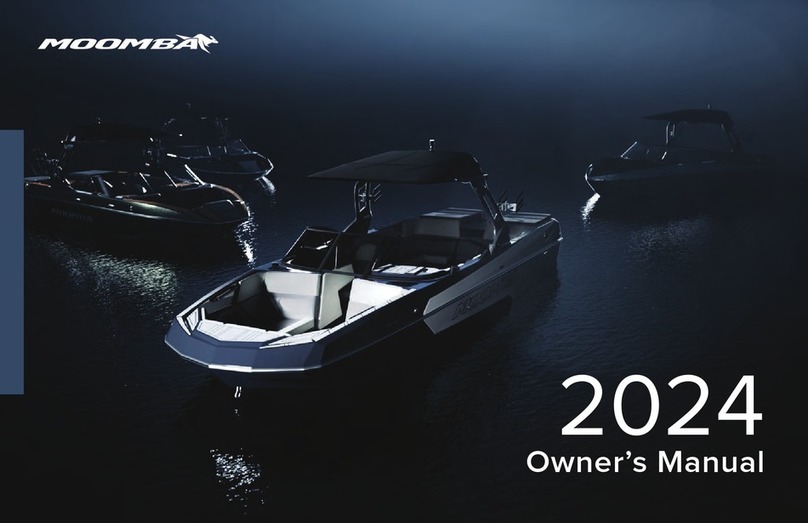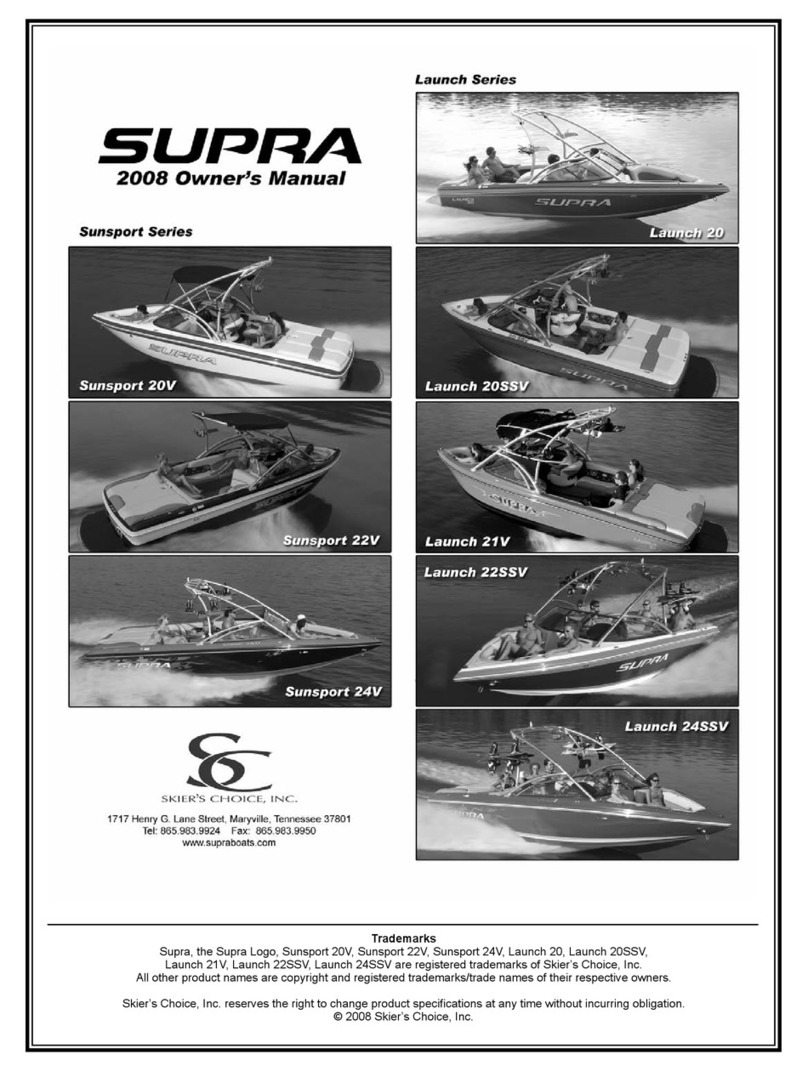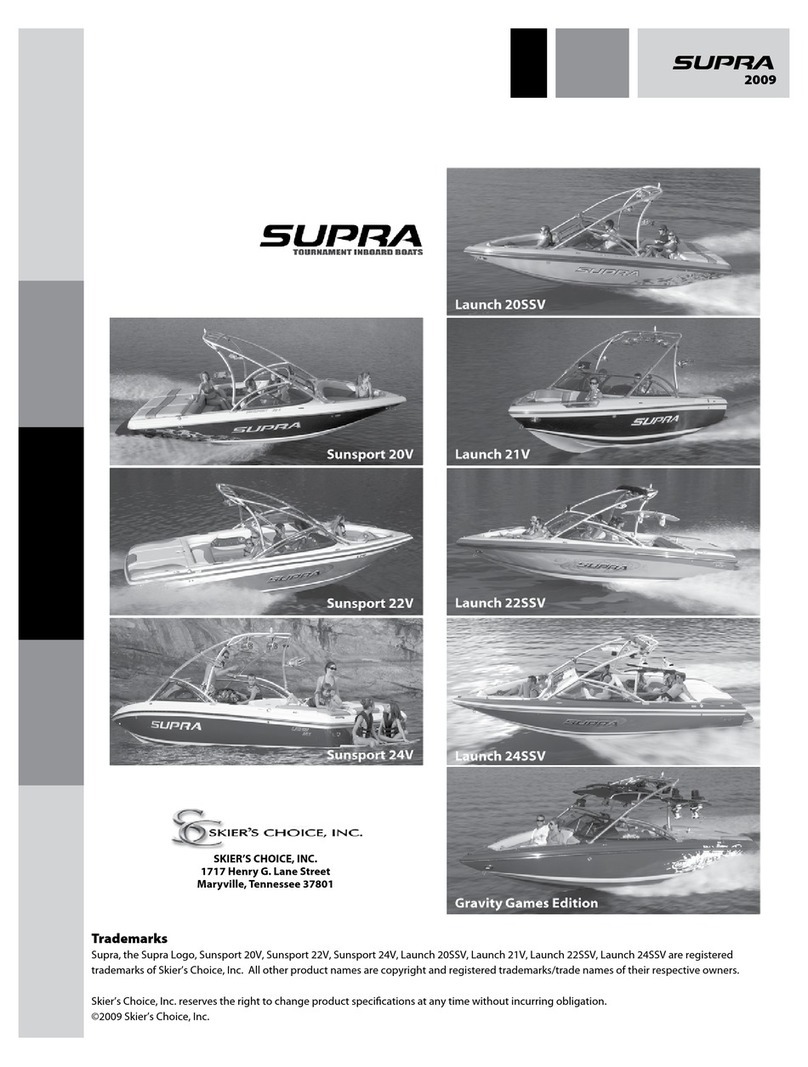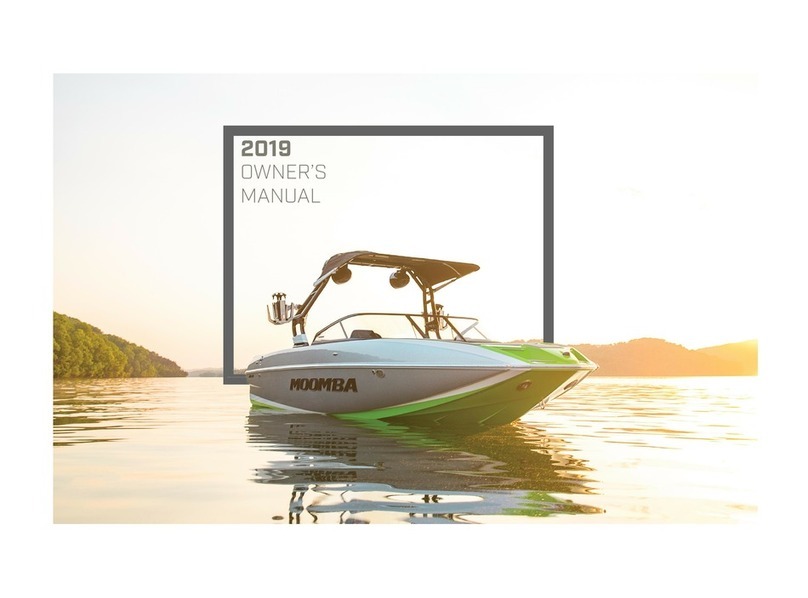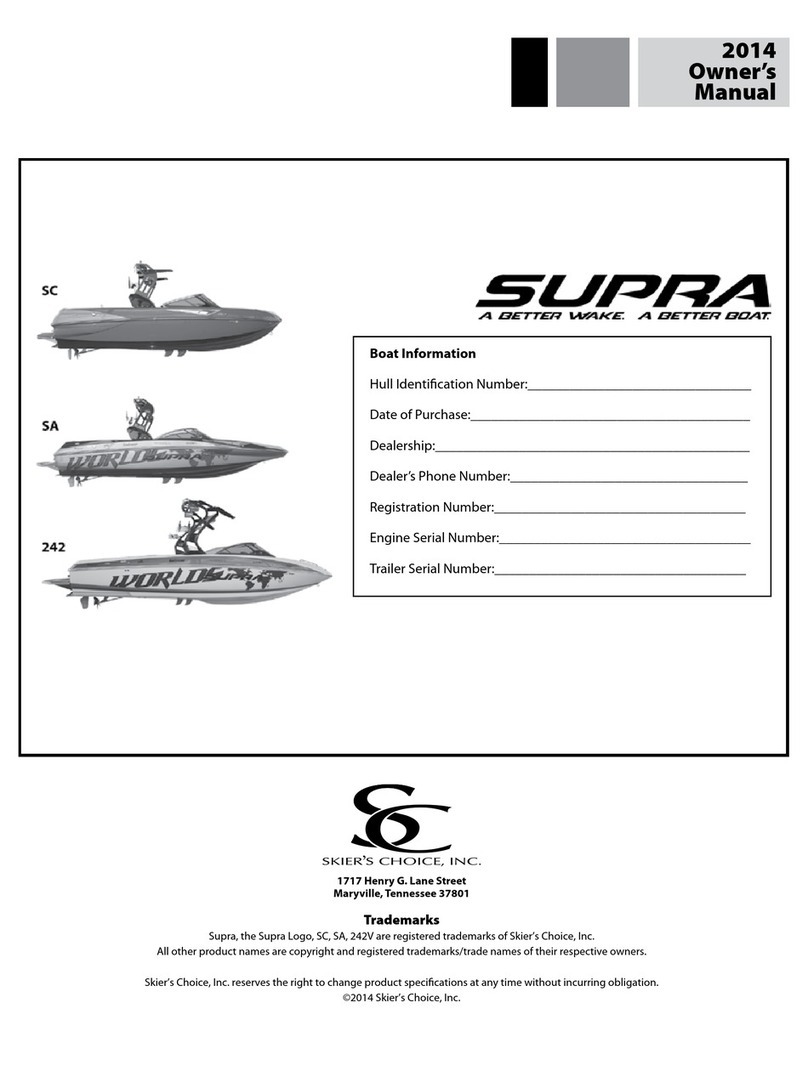Skier's Choice Moomba Kanga User manual

1
© 2002 Skier’s Choice, Inc.
5820 Hwy 411 South, Maryville, Tennessee 37801 — 865-856-3035
Trademarks
Moomba, the Moomba Logo, Kanga, Outback, Outback LS, Outback LSV,
Kamberra, Mobius, Mobius LS, and Mobius V are registered trademarks of Skier’s Choice, Inc.
All other product names are copyright and registered trademarks/trade names of their respective owners.
©2002 Skier’s Choice, Inc.
Owner Manual

2©2002 Skier’s Choice, Inc.
Table of Contents
Section I Introduction 3
Section II Boating Safety 5
Section III Boating Rules 9
Section IV Boat Specificatioins 13
Section V Operating Information 19
Section VI Starting & Operation 21
Section VII Instrument Panel 25
Sectioin VIII Equipment & Options 33
Sectiion IX Service & Maintenance 43
Section X Cleaning, Care & Storage 49
Section XI Winterization & Dry Storage 51
Section XII Technical Information 53
Section XIII Trailer Your Boat 55
Section XIV Moomba Warranty 59
Section XV Index 65
Boat Information
Hull Identification Number:______________________________________
Date of Purchase:_____________________________________________
Dealer’s Phone Number:________________________________________
Registration Number:__________________________________________
Engine Serial Number:_________________________________________
Trailer Serial Number:__________________________________________

3
© 2002 Skier’s Choice, Inc.
Introduction
Moomba inboard ski boats are manufactured by Skier’s Choice, Inc. in Maryville, Tennessee
and distributed throughout the United States and the world.
This manual provides an overview for operating your Moomba boat. It should be considered
a permanent part of your Moomba boat, and contains important information on Safety, Boating
Rules, Proper Operation and Maintenance of your boat. Should the boat be sold, this manual
will provide the same important information to the next owner.
Be sure to read and understand all aspects of Boating Safety and Operation before using your
boat. If you have any questions, your dealer can provide the information you need to have a
safe and pleasurable boating experience.
All information, illustrations and specifications
in this manual are based on the latest product
information available at the time of printing.
Moomba may discontinue models and
equipment or change specifications and
designs without any notice and without
incurring obligation.
This manual contains information about several Moomba models. Some information may not
apply to your boat since standards and optional equipment may vary from model to model.
As you read through this manual, you will find CAUTION,WARNING and DANGER symbols
which require special attention. Please read them carefully! They may tell you how to avoid
problems and/or endangering yourself, your passengers, and other boaters. PLEASE REVIEW
ALL SAFETY INFORMATION.
A maintenance schedule and accessory information are included to assure trouble-free
operation of your boat. Should service problems arise, remember that your Moomba dealer
knows your boat best and is interested in your total satisfaction.
Thank you for purchasing a Moomba boat. We hope your ownership results in an enjoyable
and rewarding boating experience. Be safe and enjoy the fun!
Section I
Introduction

4©2002 Skier’s Choice, Inc.

5
© 2002 Skier’s Choice, Inc.
Important Safety Information!
Your safety, as well as the safety of others with and around
you, is a direct result of how you operate and maintain your
boat. Read and comprehend this manual. Make sure that
you understand all the controls and operating instructions
before attempting to operate the boat. Improper operation
is extremely dangerous.
The basic safety rules are outlined in this section of the
manual. Additional precautions throughout the manual are
noted by the following symbols.
This symbol indicates a potentially hazardous circumstance,
which, if not avoided, may result in minor or moderate injury.
It may also be used to alert against unsafe practices.
This symbol indicates a potentially hazardous situation, which,
if not avoided, could result in death or serious injury.
This symbol indicates an imminently hazardous situation,
which, if not avoided, will result in death or serious injury.
This is limited to the most extreme situations.
The precautions listed in this manual and on the boat
are not all-inclusive. If a procedure, method, tool or
part is not specifically recommended by Skier’s Choice,
you must satisfy yourself that it is safe for you and
others, and that the boat will not be damaged or made
unsafe as a result of your decision.
REMEMBER: ALWAYS USE COMMON SENSE WHEN
OPERATING, SERVICING OR REPAIRING THE BOAT!
In addition to everyday safety, failure to observe safety
recommendations may result in severe personal injury or
death to you or to others. Use caution and common sense
when operating your boat. Don’t take unnecessary chances!
Be certain that all boat passengers are aware of this
information and conform to boat safety principles.
Boating Safety
Boating Safety starts with a thorough understanding of your
equipment and its proper operation. In addition to careful
review of this manual, you should be aware as well that there
are many sources of information available. Skier’s Choice
urges you to pursue additional training, such as safety and
seamanship courses offered by the U.S. Coast Guard
Auxiliary and the U.S. Power Squadron.
The following is a listing of just some of the agencies and
organizations that offer safety training or information:
- American Red Cross, National HQ
17th & D Streets NW
Washington, DC 20006
(202) 639-3686
www.redcross.org
- USA Waterski
799 Overlook Drive
Winter Haven, FL 33884
(941) 324-4341
www.usawaterski.org
- Boat Owners Association of the United States (BOAT/US)
880 South Pickett Street
Alexandria, VA 22304
(703) 823-9550
www.boatus.com
- National Safe Boating Council
2550 M Street NW, Suite 425
Washington, DC 20037
(202) 296-4588
www.safeboatingcouncil.org
- U.S. Coast Guard Auxiliary Commandant (G-NAB)
2100 Second Street SW
Washington, DC 20593-0001
(800) 336-2628
www.cgaux.org
- U.S. Power Squadron
www.usps.org
- On-Line Basic Boating Safety Course available
at:www.boatsafe.com
Federal law requires certain safety equipment to be on-board
at all times. In addition, responsible boaters carry other
equipment in case of emergency. Check with the local
boating authorities for any additional requirements over and
above the federal stipulations.
Section II
Boating Safety

6©2002 Skier’s Choice, Inc.
Safety Equipment
Your Moomba has been equipped at the factory with most
of the federally required safety equipment for inland waters
(Class 1, 16’-to-26’). This equipment includes:
- UL-approved Marine Fire Extinguisher, Type A-BC (2 lbs.),
good for solids, liquids, and electrical fire
- ABYC-approved Marine Mufflers with water injection
- USCG-approved Marine Flame Arrestor
- USCG-approved Engine Box Ventilation with spark-less
power blower
- ABYC-approved Electric Horn sound warning device
- USCG-approved inland lighting
Federal law also requires at least one Type I, II or III Personal
Flotation Device (PFD) for each person on board or being
towed on water skis or other recreational equipment. In
addition, one throwable Type IV PFD must also be on board.
As the owner, obtaining the appropriate PFDs is your
responsibility. Your Moomba dealer can—and will be happy
to assist you.
NOTE: Requirements for coastal waters and inland
waters differ. Check with the local authorities for more
information.
A smart owner will avoid potential problems on an outing by
having additional equipment on board. Normally, this
equipment is dependent on the body of water and the length
of the trip.
We suggest the following—as a minimum. Your Moomba
dealer can also assist you with additional recommendations.
- An anchor with at least 75-feet of line
- A manual bailing device for removing water
- A combination oar/boat hook
- A day-and-night visual distress signal
- A first aid kit and manual
- An airway breathing tube
- A waterproof flashlight
- A set of local navigation charts
- Mooring lines and fenders
- Extra engine oil
- A tool kit
- A portable AM/FM radio or weather radio
Boating-related accidents are generally caused by the
operator’s failure to follow basic safety rules or written
precautions. Most accidents can be avoided if the operator
is completely familiar with the boat, its operation, and can
recognize potentially hazardous situations before an accident
occurs.
Failure to adhere to these precautions may result
in severe injury or death to you and/or others.
- Improper operation is extremely dangerous. Operators
must read and understand all operating manuals supplied
with the boat before operation.
- On-board equipment must always conform to the
governing federal, state, and local regulations.
- Small children in the bow of the boat should be
accompanied by an adult at all times.
- Never stand or allow passengers to stand while the boat
is moving. You or others may be thrown from the boat.
- Never operate the boat while under the influence of alcohol
or other drugs.
- Gasoline vapors can explode. Before starting engine,
open engine box, check engine compartment for gasoline
vapors, and operate blower for at least 4 minutes. Run
blower below cruising speed.
- Leaking fuel is a fire and explosion hazard. Inspect system
regularly. Examine fuel tanks for leaks or corrosion at
least annually.
- Never override or modify the engine safety shut-off switch
or engine neutral starting safety switch in any way.
- Never remove or modify components of the fuel system
in any way except for maintenance by qualified personnel.
Tampering with fuel components may cause a hazardous
condition.
- Never allow any type of spark or open flame on board. It
may result in fire or explosion.
- It is the owner’s responsibility to check tightness of the
Rad-A-Cage Tower bolts BEFORE each use.
- The Rad-A-Cage Tower is designed to pull a single (1)
individual. DO NOT climb or sit on the Rad-A-Cage Tower.
Rope may loop on inverted tricks. DO NOT sit behind
the pulling point of the Rad-A-Cage Tower.
General Safety Precautions
- To avoid serious personal injury, DO NOT be on or about
the swim platform while engine is running and keep away
from rear of boat while engine is running.
- To avoid serious personal injury, DO NOT operate engine
while anyone is on or about the swim platform or in the
water near the boat.

7
© 2002 Skier’s Choice, Inc.
Failure to adhere to these warnings may result in severe
injury or death to you and/or others.
- Every skier must always wear a USCG-approved personal
flotation device.
- Maintain a distance of at least 100 feet from all other
objects, including other boats, piers, rafts, mooring and
navigational buoys, pilings, abutments, or any other items.
- Always have an experienced driver and observer in the
boat when skiing.
- Never ski in shallow water, close to shore, or in water where
you do not know the depth or what is beneath the surface.
- Never put your arm, head, or any other part of your body
through the handle-bridle of the ski line nor wrap the line
around any part of the body at any time.
- Never ski at night, or directly in front of other boats.
- Never jump from a boat that is moving at any speed, nor
enter or exit the water when the engine is running (ON).
- Make sure that everyone knows and uses approved skiing
hand signals and common skiing courtesy.
Skiing Safety
Skiers are obligated to be as aware of the fundamental safety
rules as well as the boat operator. If you are new to water
skiing, seek certified training before starting. You will find it
especially helpful to join a local ski club and USA Waterski
when possible.
Always remember that the majority of water skiing injuries
are the result of impacts with other objects, so always look
where you are going and be aware of what is going on around
you.
- The tow bar is not designed for vertical extensions. Any
modifications to the tow bar or its mountings may result in
damage to the boat and injury to the user.
- Rear storage area is located above the gas tank and is
not designed for ballast. Weight limit is 150 lbs. equally
distributed.
- The Rad-A-Cage Tower may strike low objects. Check
clearance height around docks, shore, overhanging
objects, bridges and power lines.
-DO NOT pull past 45 degrees of the centerline of the
boat. Failure to follow this rule could result in the boat
capsizing.
General Safety Precautions (continued)
Ski Pylon Extensions
The use of a ski pylon extension or extensions in excess of
7-feet vertical is not recommended by Moomba on our
products. If you elect to use merchandise such as these, be
aware that they could create excessive stress on your boat
and subjectively cause damages not covered by the warranty.

8©2002 Skier’s Choice, Inc.
Warning Plates and Labels
Read and note ALL warning plates and labels from bow to
stern that appear on the boat, including these!

9
© 2002 Skier’s Choice, Inc.
Basic Boating Rules
You should be aware of these rules and follow them
whenever you encounter another vessel on the water.
The rules presented in this manual are condensed and have
been provided as a convenience only. Consult your local
U.S. Coast Guard Auxiliary (USCGA) or Department of Motor
Vehicles (DMV) for a complete set of rules governing the
waters in which you will be using your boat. If you plan to
travel—even for a short trip—you would be well served to
contact the regional USCGA or DMV in the area where you
will be boating.
Review and understand all local and state laws.
Any time two vessels on the water meet one another, one
vessel has the right-of-way. It is called the stand-on vessel.
The vessel which does NOT have the right-of-way is called
the give-way or burdened vessel.
These rules determine which vessel has the right-of-way,
and accordingly, what each vessel should do.
The vessel with the right-of-way has the duty to continue its
course and speed, except to avoid an immediate collision.
When you maintain your direction and speed, the other vessel
will be able to determine how best to avoid you.
The vessel which does not have the right-of-way has the
duty to take positive and timely action to stay out of the way
of the stand-on vessel. Normally, the give-way vessel should
not cross in front of the stand-on vessel. Slow down or
change directions briefly and pass behind the other vessel.
You should always move in such a way that the stand-on
operator can see what you are doing.
This rule is called Rule 2 in the International Rules and says,
“In obeying and construing these rules due regard shall be
had to all dangers of navigation and collision, and to any
special circumstances, which may render a departure from
the above rules necessary in order to avoid immediate
danger.”
Encountering Other Vessels
There are three main situations in which you may encounter
other vessels and you must observe the Steering Rules in
order to avoid a collision. These are:
-Meeting (you are approaching another vessel head-on)
-Crossing (you are traveling across the other vessel’s path)
-Overtaking (you are passing or being passed by another
vessel)
Using the following illustration in which you are the boat in
the center, you should give right-of-way to all vessels shown
in the white area. In this instance, you are the give-way
vessel. All vessels in the shaded area must yield to you as
you are the stand-on vessel. Both you and the meeting vessel
must alter course to avoid each other.
If you are meeting another power vessel head-on, and you
are close enough to run the risk of collision, neither of you
has the right-of-way. Both of you should alter course to avoid
an accident. You should keep the other vessel on your port
(left) side. This rule doesn’t apply if both of you can clear
each other by continuing your set course and speed.
Section III
Boating Rules

10 ©2002 Skier’s Choice, Inc.
When two power-driven vessels are crossing each other’s
path close enough to run the risk of collision, the vessel
that views the crossing vessel to the starboard (right) side
must give-way.
If the other vessel is to the port (left) side, maintain your
course and direction, provided the other vessel gives you
the right-of-way as it should.
If you are passing another vessel, you are the give-way
vessel. This means that the other vessel is expected to
maintain its course and speed. You must stay out of its
way as you clear it, altering course and speed as
necessary.
Conversely, if you are being passed by another vessel,
you should maintain your speed and direction so that the
other vessel can steer itself around you.
There are three other rules to always remember when
driving your boat around other vessels.
When navigating in narrow channels, you should keep to
the right when it is safe and practical to do so. If the
operator of a power-driven vessel is preparing to go
around a bend that may obstruct the view of other water
vessels, the operator should sound a prolonged blast on
the whistle or horn—four to six seconds.
If another vessel is around the bend, it too should sound
the whistle or horn. Even if no reply is heard, however, the
vessel should still proceed around the bend with caution.
If you navigate these type of waters, you should carry a
portable air horn, which are available from local marine
supply stores.
All vessels which are fishing with nets, lines or trawls are
considered under International Rules to be fishing vessels.
Boats with trolling lines are not considered fishing vessels.
Fishing vessels have the right-of-way, regardless of
position. These vessels, however, cannot impede the
passage of other vessels in narrow channels.
Sailing vessels should normally be given the right-of-way.
The exceptions to this are:
- When the sailing vessel is overtaking the power-driven
vessel, the power-driven vessel has the right-of-way.
- Sailing vessels should keep clear of any fishing vessel.
- In a narrow channel, a sailing vessel should not hamper
the safe passage of a power-driven vessel which can
navigate only in such a channel.
The waters of the United States are marked for safe
navigation by the lateral system of buoyage. The markers
and buoys you will encounter have an arrangement of
shapes, colors, numbers and lights to show which side of
the buoy a boater should pass when navigating in a
particular direction.
The markings on these buoys are oriented from the
perspective of being entered from seaward while the
boater is going towards the port. This means that red
buoys are passed on the starboard (right) side when
proceeding from open water into port, and black buoys
are to port (left) side. When navigating out of port, your
position to the buoys should be reversed: red buoys to port
and black buoys to starboard.
Many boating bodies of water are entirely within the
boundaries of a single state. The Uniform State Waterway
Marking Systems has been devised for these waters. This
system uses buoys and signs with distinctive shapes and
colors to show regulatory or advisory information.
These markers are white with black letters and orange
borders. The information signifies speed zones, restricted
areas, danger areas and general information.
Remember: Markings may vary by geographic location.
Always consult local boating authorities before driving your
boat in unfamiliar waters.
(See examples of buoys and markers next page.)

11
© 2002 Skier’s Choice, Inc.

12 ©2002 Skier’s Choice, Inc.

13
© 2002 Skier’s Choice, Inc.
Outback
Length without Platform: 20’-6”
Length with platform: 22’-0”
Beam: 7’ 8”
Draft: 22”
Weight: 2450 lbs.
Fuel Capacity: 27 gal.
Standard power: 310 hp
Optional Power: 320 to 330 hp
Specifications
Section IV
Boat Specifications

14 ©2002 Skier’s Choice, Inc.
Outback LS
Length without Platform: 20’-8”
Length with platform: 22’-8”
Beam: 95”
Draft: 22”
Weight: 2650 lbs.
Fuel Capacity: 28 gal.
Standard power: 310 hp
Optional Power: 320 to 330 hp
Specifications
Outback LSV
Length without Platform: 20’-8”
Length with platform: 22’-8”
Beam: 95”
Draft: 24”
Weight: 3,000 lbs.
Fuel Capacity: 40 gal.
Standard power: 310 hp
Optional Power: 320 to 330 hp
Specifications

15
© 2002 Skier’s Choice, Inc.
Mobius
Length without Platform: 20’-8”
Length with platform: 22’-8”
Beam: 95”
Draft: 22”
Weight: 2650 lbs.
Fuel Capacity: 28 gal.
Standard power: 310 hp
Optional Power: 320 to 330 hp
Specifications
Length without Platform: 22’
Length with platform: 24’-2”
Beam: 95”
Draft: 24”
Weight: 3,250 lbs.
Fuel Capacity: 40 gal.
Standard power: 310 hp
Optional Power: 320 to 330 hp
Seating Capacity: 12 persons
Specifications
Kamberra
Walkabout

16 ©2002 Skier’s Choice, Inc.
Length without Platform: 22’
Length with platform: 24’-2”
Beam: 95”
Draft: 24”
Weight: 3250 lbs.
Fuel Capacity: 40 gal.
Standard power (MPI): 310 hp
Optional Power: 320 to 330 hp
Specifications
Mobius V
Length without Platform: 20’-8”
Length with platform: 22’-8”
Beam: 95”
Draft: 24”
Weight: 3000 lbs.
Fuel Capacity: 40 gal.
Standard power (MPI): 310 hp
Optional Power: 320 to 330 hp
Specifications
Mobius LSV

17
© 2002 Skier’s Choice, Inc.
Kanga
Length without Platform: 20’-6”
Length with platform: 22’-0”
Beam: 7’ 8”
Draft: 22”
Weight: 2450 lbs.
Fuel Capacity: 27 gal.
Standard power: 310 hp
Optional Power: 320 to 330 hp
Specifications

18 ©2002 Skier’s Choice, Inc.

19
© 2002 Skier’s Choice, Inc.
BREAK IN
Taking care to properly break in your new engine will pay off
in the long run. In our years of field testing, we have proven
that an Indmar engine, when properly broken in according
to our simple procedures, will last longer, run better and have
fewer repairs over its lifetime.
Your new engine does not require an elaborate break-in
procedure. Just follow these simple instructions and you
are off to a great start.
The three (3) most important aspects of new engine break-
in are:
1.Avoid running engine at high speeds.
2.Do not carry a heavy load (passengers, gear, etc.).
3.Vary your boat speed during break-in, don’t run at the
same RPM for a long period of time.
BREAK-IN STEPS
- For the first hour, do not exceed 2,000 RPM.
- For the second hour, do not exceed 3,000 RPM.
- For the next five hours, do not exceed 4,000 RPM.
BREAK-IN TIPS
- Avoid fast accelerations and don’t carry (or pull) a heavy
load during this period.
- Always let engine warm up gradually before acceleration.
- Check oil frequently. During the first 50 to 100 hours, an
engine can use more oil than usual. Maintain oil at a proper
level at all times (do not overfill).
- Monitor transmission fluid levels.
- Report abnormal noises or vibrations to your dealer.
- Keep an eye out for loose mountings, fittings, nuts, bolts,
and clamps.
During the BREAK-IN process, engine temperature should
be carefully monitored and speed should be reduced if
overheating is evident. ALSO, PLEASE REFER TO
ENGINE OWNER’S MANUAL FOR BREAK-IN
INFORMATION.
NOTICE: PLEASE REFER TO ENGINE OWNER’S
MANUAL for maximum RPM and engine break-in
procedure.
After the first 10 to 20 hours of operation, take your boat to
the dealer for its first oil and filter change, as well as an
engine checkup. Remember to keep a sharp eye on all
gauges and warning lights during these first hours of
operation. Report anything unusual to your dealer.
After the break-in procedure is over, your boat may be
operated continuously at any speed.
Do not exceed maximum RPM recommended for your
engine. Exceeding the maximum RPM may result in
damage to the engine.
Before starting your engine you must open the engine
box and check engine compartment and bilge for
gasoline and oil vapors.
Section V
Operating Information

20 ©2002 Skier’s Choice, Inc.
Maximum Capacities
In compliance with United States Coast Guard Regulations,
Moomba Boats meet or exceed all safety standards designed
for recreational boats. To ensure safe handling and
performance, each Moomba boat displays a maximum
capacity sticker (see sample), stating the maximum
passenger weight load allowable.
NOTICE: Refer to the Maximum Capacity Sticker on
your boat for allowable loading.
Coast Guard Regulations
The United States Coast Guard boating regulations prescribe
minimum standards of safety to be met and maintained by
all watercraft. It is necessary that your boat remain in
compliance with these regulations.
The staff at Skier’s Choice, Inc. recommend that all boat
operators complete a Coast Guard approved boating safety
course.
Your Moomba boat cover is made from the finest canvas
and webbing to insure that your boat will be protected in the
off season. The cover has been designed to fit securely
around each boat. If your new cover does not seem to be
snug, a shrinkage allowance has been sized in.
Use the following procedure when covering the boat:
1.Be sure that the cover fits snugly at the bow then unfold
from front to back.
2. Be sure to install cover pole(s) and adjust to proper height,
using set screw on pole(s). This will keep water from
gathering in the center, which can damage the cover.
3.Secure all fastening straps around the trailer frame.
4.Pull the draw cord equally from both sides and tie off to
the lifting eyes on the stern in accordance with the
illustration.
Folding Cover
When folding the cover for storage, be sure the cover is dry.
Take care not to scratch the canvas finish against rough
surfaces. Store in a dry location.
Cover Repair
If the cover becomes damaged, immediately patch and
reseal the area. Use a tent seam sealer to reseal any new
stitches. Spray fabric guard on scraped or worn surfaces.
Canvas tears should be repaired professionally and stitches
sealed to prevent leakage.
Your mooring cover is not designed for trailering. Trailering
with your cover installed may cause premature cover failure
and boat damage. This damage is not warrantable.
Canvas Cover
This manual suits for next models
6
Table of contents
Other Skier's Choice Boat manuals
Popular Boat manuals by other brands

Jeanneau
Jeanneau SUN ODYSSEY 41 DS owner's manual

Meridian
Meridian 490 Pilothouse owner's manual

Advanced Elements
Advanced Elements AdvancedFrame Expedition AE1009 owner's manual

Robo Marine Indonesia
Robo Marine Indonesia GEOMAR user manual

Swallow Boats
Swallow Boats BayRaider owner's manual

X SHORE
X SHORE EELEX 8000 owner's manual
